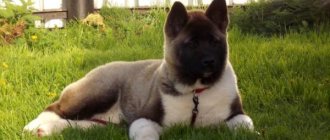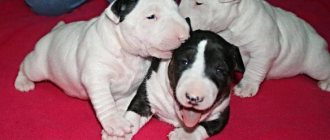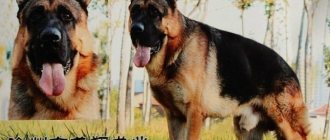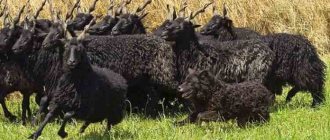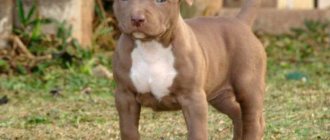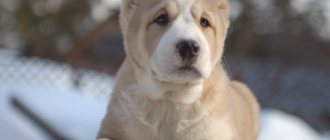Brief characteristics of the dog
- Other possible dog names: Tosa-ken, Japanese Mastiff, Tosa, Tosa Inu, Japanese Great Dane, Japanese Tosa, Tosatoken, Tosa Token, Tokyo Fighting Dog, Japanese Fighting Dog, Sumo Dog, Tosa Fughting Dog.
- Adult height: female from 55 cm, male from 60 cm.
- Weight: 30-60 kg.
- Characteristic color: red, apricot, black, fawn, brindle, with a black mask, white chest and paws.
- Coat length: short, smooth.
- Life expectancy: 10-12 years.
- Advantages of the breed: balanced, intelligent, non-aggressive, patient, hardy, good with children.
- Difficulties of the breed: require professional training.
- Average price: Tosa Inu costs from $1,000 to $5,000 or more.
Appearance
Tosa Inu is a large short-haired dog of a slightly elongated format, athletic build with strong bones. The Tosa Inu's appearance inspires fear and apprehension; its movements are light and swift. The minimum height at the withers is 60 cm for males and 55 cm for females. Weight is not specified by the standard; first of all, the dog must be proportional.
The skull is wide. The stop is pronounced. The muzzle is outlined by noticeable symmetrical folds, moderately long with a straight bridge of the nose, which ends in a large black lobe. The jaws are strong. The teeth are strong and meet in a scissor bite. The eyes are relatively small and dark brown in color. The ears are relatively small, thin, set high, located on the sides of the skull and held close to the cheekbones. Puppies have larger ears relative to their heads than adult dogs.
The neck is muscular with a well-defined dewlap. The withers are high. The back is straight and level. The loin is wide. The croup is slightly convex. The tail is thick at the base and tapers towards the end. Kept downwards, raised during movement or excitement. The chest is broad and deep with moderately sprung ribs. The stomach is well tucked. The legs are strong, moderately long with well-developed muscles. The paws are tightly packed with elastic, thick pads and hard dark claws.
The coat is short, thick and hard. The color can be apricot, black, brindle, fawn or red.
Small white spots are allowed on the paws and chest.
History of the origin of the breed
Tosa Inu or Toza Inu is the only Japanese dog from the Molosser group .
Until the mid-19th century, Japan had a national fighting breed, Shikoku (Shikoku) Ken, bred on the island. Shikoku. Many centuries ago, samurai returning from war needed to periodically “let off steam” while waiting between campaigns. Then the emperor decided to legalize dog fighting , which had existed in Japan since the 14th century, and issue an order requiring the presence of samurai at them, where they could throw out their accumulated emotions. This action quickly gained popularity, and a demand for fighting dogs appeared .
In 1853-54, the era of Japan's self-isolation from the rest of the world ended. A wave of merchants poured into the country, and with them dogs began to arrive to take part in the famous Japanese battles.
These fights were more humane, as they were more reminiscent of traditional Japanese sumo and stopped as soon as the dog knocked the opponent to the floor. As a result, the dogs did not receive serious injuries.
Local dogs were significantly inferior in strength and endurance to visiting fighters. Then the need arose for a new, stronger breed, which is what local dog handlers began to do. Consistently crossing the Shikoku Ken with other breeds, in 1868 they got a hardy, agile, agile and indifferent to pain dog, which they named Tosa Inu in honor of the prefecture where it was bred.
The Tosa Inu has St. Bernard, English Mastiff, Bull Terrier, Great Dane and German Pointer in its blood. The exact sequence of breeding of the breed is kept in the strictest confidence to this day , as a national secret. Dog handlers from other countries are trying to describe this scheme in their own way.
Tosa Inu instantly gained popularity both among local dog fighting fans and among foreigners. But dogs were not allowed to be taken out of the country . The breed received its standard already in 1925. And in 1930, the Association for the Preservation and Popularization of the Breed was created.
The Second World War, and then the plague epidemic, almost destroyed the breed . Thanks to the fact that enthusiasts managed to select 12 of the most prominent representatives and evacuate them to the northern part of Japan, the breed survived. In addition, in the chaos of the war, several individuals ended up in Korea, Taiwan and America. All this helped preserve the breed and restore its numbers.
Tosa Inu is recognized by many international cynological organizations, and even in 2000 received approval from the FCI. It is believed that the Japanese representatives of the breed are the most consistent with the standard, significantly outperforming their Korean and American counterparts.
Dog nicknames: names for Tosa Inu
Most people prefer to choose a short, sonorous name for their dog.
You will have to say your dog's name many times a day, and if it is too long, it will be tiring.
When choosing what to name your Tosa Inu, you can follow two methods.
- The first and easiest: open the list of the most suitable names for this breed and choose the one that you like best .
- Second: choose an unusual name from other sources, for example, from mythology or literature, name the dog after your favorite celebrity , or come up with your own exclusive name .
There are many suitable names for Tosa Inu girls:
- Ima (gift)
- Yuri (lily),
- Kita (north),
- Mai (bright),
- Tama (gemstone)
- Hana (flower),
- Aiko (favorite child).
The following names are good for a Tosa Inu boy:
- Taro (firstborn),
- Raiden (god of thunder)
- Ricky (strong)
- Kin (golden),
- Akiro (smart)
- Toru (sea).
Purpose of the breed
Tosa Inu samurai dogs are primarily intended for participation in dog fighting . It was for this purpose that they were bred. In their free time from fighting, Tosa Inu faithfully serve their owners as ideal guards, watchmen and bodyguards .
Tosa Inu can be found in rescue and search teams. also used in canistherapy , that is, treatment and rehabilitation with the help of dogs. They make wonderful companions not only for adults, but also for children . They are also family favorites.
Description of the nature of the breed
Tosa Inu have a dual nature , but they clearly know where and when to apply certain qualities of their character. In the ring they have no equal in fearlessness, endurance and toughness . These dogs are indifferent to pain and are ready to bravely rush at the enemy, instantly assessing the situation and making their own decisions.
Tosa are not warned of an attack by barking , but immediately capture the object of the threat. The Tosa Inu has the same behavior towards uninvited guests. They greet all strangers with great distrust, but without displaying unreasonable aggression.
Even during a fight, dogs are not allowed to bite the opponent or make a sound - otherwise the dog is removed from further participation. This only applies to traditional Japanese fighting. With dogs that live with Tosa Inu in the same house, they build a clear hierarchy, placing themselves in the position of leader.
Looking at their terrifying appearance, it is impossible to guess that Tosas are kind and balanced dogs that can patiently and carefully babysit a small child. These dogs do not pose any threat to the family and rarely speak . But for this they need early professional education and strict training.
Tosa Inu needs a confident owner with experience in keeping similar breeds. These dogs have a rare analytical mind, excellent memory and intelligence . Therefore, it will not be difficult for an experienced owner to properly train his pet.
Character traits
Only a person of strong character, and certainly not a beginner, can properly raise a dog of this breed.
Mastiffs are neither stupid nor uncontrollable . On the contrary, they are distinguished by attentiveness, balance, intelligence and calmness.
But behind this there is also a great inner strength, which only a person equally strong internally can subjugate.
Leadership qualities are important when raising and training a mastiff..
The dog has developed protective potential. She will always stand up for the owner and those people who have earned her respect. He is quite wary of strangers, although without barking or aggression.
The dog senses the mood of people, so it does not tolerate falsehood and pretense . In a relationship with a mastiff, you need to be sincere and open, show your real intentions. This is the only way you can win the dog’s favor.
Hitting a mastiff is a bad decision . He will be angry with you, he will be afraid, and this is not respect. In this case, be prepared for the fact that at the decisive moment the dog will simply turn away from you.
Mastiffs do not like unfamiliar dogs or other pets in general. They will treat them with aggression only if they did not grow up together.
The dog is difficult to train, so it should be trained from an early age.
“Four-legged sumo” is the name given to Tosa Inu dogs in Japan. This name arose due to the fact that Tosa is similar in many characteristics to heavy sumo wrestlers. The Japanese Mastiff was bred as a fighting dog. He is heavy, large, fearless, practically insensitive to pain, and has a firm, strong character.
How to choose a puppy
The choice of a Tosa Inu puppy must be taken very seriously, as this breed is not cheap. As a rule, nurseries strictly monitor compliance with the standard, as well as the psychological and physical condition of the entire litter.
It is recommended to purchase puppies no earlier than they are two months old . By this age, puppies will be fully strengthened, independent and will have absorbed everything their mother has to teach them. In addition, possible health problems, defects and inconsistencies will be visible.
Choose a medium-sized puppy with no visible defects in the jaw, eyes or ears . The slightest lameness may indicate problems with the joints. Also pay attention to the fur. Its dullness indicates health problems. Feel your stomach. It should be soft and without any hardening around the belly button. This is how the absence of an umbilical hernia is determined.
In a male dog, two testes should be palpable in the scrotum. Otherwise, the puppy will experience cryptorchidism (the absence of one or two testes).
The puppy should be moderately well-fed, cheerful and active . Clap your hands loudly over the puppy. If he huddles to the ground or runs away, it means he has cowardice, which is completely unacceptable for this breed. It is better to choose the one who ran up to meet you with curiosity.
Choosing a Tosa Inu puppy
It is extremely difficult to buy a puppy in Japanese nurseries. The Japanese are reluctant to export their dogs, especially Tosu Ken, which are a national treasure and the pride of the country. The bulk of the Tosa Inu population is concentrated in Japan, Taiwan, South Korea and the Hawaiian Islands. Mostly dogs are owned by owners of rich estates who need reliable protection. Korean dogs, as a rule, are slightly smaller than their counterparts from Japan, Europe and America, have thinner bones, but they often have the most beautiful and valuable red color.
Future owners, first of all, need to think not about choosing a puppy, but about choosing a kennel and parents, who should have not only a beautiful appearance, but also a good character.
It will be great if you have the opportunity to look at them in everyday life, evaluate their habits, temperament and degree of obedience. If everything is satisfactory, they move on to choosing a puppy from the litter. It is advisable to decide in advance on gender, color and character. For families with children, it is better to get a bitch with a calm character; you can also take a male dog to guard the house, provided that the future owner can cope with the dominant personality of the dog. If you need a dog for exhibitions and breeding, you often need the help of an experienced breeder or dog handler, and if you need a companion dog and a bodyguard, they usually focus on personal preferences and take the puppy they like. The optimal age at which you can take a little Tosu to a new home is 3 months.
Price
The breed is quite rare, most producers are imported from other countries, so it is not surprising that the price of a Tosa Inu puppy rarely falls below 70,000 rubles. In this case, we are talking about promising babies from nurseries. By the way, it is very, very rare to come across advertisements for the sale of puppies without a pedigree at this stage of the breed’s development.
Care and maintenance
Tosa Inu are not adapted to life in a city apartment . A private house with a spacious yard is more suitable for them.
These dogs need a lot of exercise and the ability to move freely . A chain or a permanently closed enclosure will ruin the dog’s character and it will become either withdrawn and depressed, or angry and aggressive. Fortunately, the first option happens more often, and the owners get a phlegmatic pet instead of an active guard.
Short hair is not able to protect the Tosa Inu from frost , so he needs a comfortable kennel. Some people take the dog indoors at night.
To remove dust and dirt from the fur and to give it shine, you can periodically wipe the dog with a damp cloth or a special glove. It is recommended to bathe the Tosa Inu no more than two or three times a year using a special shampoo.
Once a week you need to clean your pet's ears. Carry out regular prevention and, if necessary, control of worms and fleas.
Possible health problems
Typical diseases that occur in Tosa Inu include:
- inflammation of the mucous membrane of the eyes;
- allergic dermatitis;
- urolithiasis disease;
- dysplasia of the elbow and hip joints;
- heart failure.
Fortunately, no severe hereditary diseases have been identified . Despite the strong immunity, the dog still needs preventive vaccination against viral infections, which can lead to serious consequences.
Character and temperament of the animal
The Japanese fighting dog must have composure and courage, but at the same time be patient, friendly, and calm. Tosa Inu is an obedient dog; it can lie aside for a long time on the orders of its owner, and treat house guests with calm indifference, without showing hostility. But still, both the owner and the guests of the home must be careful in its presence. When danger is detected, its attack will be lightning fast, without warning barking.
Important! There is no aggression towards people in this breed. The Japanese trust mastiffs to look after their young children. However, these dogs are very angry and hostile towards their own kind, ready to attack.
Friendly and calm mastiff
Nutrition for puppy and adult dog
For such an active dog as the Tosa Inu, a diet that consists of at least 30% protein . This can be lean meat, offal and sinew . Once or twice a week it is recommended to replace meat with sea fish or seafood . The carbohydrate part consists of cereals , sometimes in combination with vegetables. You should also take different vitamin supplements according to your age and needs.
When feeding on industrial feed, there is no need for vitamin supplements, but provided that the feed class is not lower than Premium. The food can be either dry or canned, the main thing is to choose it correctly.
An adult dog is fed twice a day , trying to do it at the same time. For a growing puppy, the initial daily feeding is four to five servings per day.
Smoked meats, yeast baked goods and sweets are completely excluded from the dog's diet.
Training and education
Despite the dog’s intelligence and intelligence, the Tosa Inu, like any other fighting breed, must be trained by an experienced person. If you do not have experience in raising such dogs, then it is better not to get a Tosa at all or leave the training to a professional trainer.
At the beginning of training, it is important to gain the dog's trust and become its unquestioning leader . It is not recommended to use force against Tosa Inu . Also, do not neglect rewards with praise or treats.
These dogs are able to quickly remember commands given both by voice and by gestures.
The main thing is to approach the training process responsibly and establish yourself correctly in front of your pet.
Pet health
Tosa Inu is a dog that is resistant to diseases. Due to its massive build, this breed may develop elbow dysplasia, a disease that causes their destruction and is characterized by pain and lameness. To avoid this, it is recommended to purchase a puppy only from trusted breeders or in specialized nurseries, where producers with dysplasia are not allowed to breed, since experts believe that this is a hereditary disease. X-ray examinations should be carried out regularly (at least once a year) to detect the disease at an early stage.
The average number of puppies in a litter is 6-8.
The life expectancy of representatives of the breed is 10-12 years.
The Tosa Inu, a Japanese fighting dog, is certainly not suitable for beginners who have little experience in raising and training animals. When purchasing a puppy of this type of breed, you should remember that responsibility for raising the pet and possible aggressive behavior primarily lies with its owner.
Advantages and disadvantages
Tosa Inu are capable of creating the wrong impression about themselves . When you observe their behavior in the ring, it is difficult to imagine that such a dog can patiently allow itself to be cuddled by a small child, and in general be kind and sensitive . And when you see her playfully running around surrounded by her beloved owners, you can’t believe that she is capable of showing all her power and strength in an instant if such a need arises.
This is a balanced and unnecessarily non-aggressive dog . In her work, her actions are aimed more at capturing the enemy than at destroying him . But in any case, it acts without warning.
Tosa is one of the breeds that requires special training and constant work with them. Therefore, novice dog breeders should think carefully before getting such a pet.
This is a hardy, fearless and energetic dog . And she transfers her working qualities to the protection and security of her family. Tosa is not suitable for keeping in city high-rises , as well as for weak-willed and elderly people who may not be able to cope with its pressure.
Advantages and disadvantages
Advantages:
- Calmness and balance;
- A certain phlegmatic attitude towards others when everything is calm;
- Acute sense of smell and hearing;
- Quick response to what happened;
- Security and protective potential;
- Always comes to the owner's defense;
- Majestic appearance;
- Developed muscles.
Flaws:
- They are difficult to educate and train;
- If these aspects are delayed, the dog will grow up to be aggressive, controlled and antisocial;
- Not suitable for apartment;
- Not suitable for spending time with children;
- He has a strong character and obeys a person with authority, which in itself is not easy.
Sources
- https://kot-pes.com/tosa-inu-foto/
- https://lapkins.ru/dog/tosa-inu/
- https://nekusaka.com/porody-sobak-nazvaniya-foto/sobaka-tosa-inu-opisanie-porody-harakteristika-uhod-foto-yaponskogo-mastifa.html
- https://prohvost.club/sobaki/porody-sobak/tosa-inu-foto.html
- https://domashnij-zapovednik.com/sobaki/porody-s/mastif/tosa-inu.html
- https://sobaky.info/tosa-inu/
[collapse]
Owner reviews
Arkady:
My Tosa was brought by a friend from the Land of the Rising Sun, since I could not find a suitable nursery here. To describe a dog in a nutshell, it is the kindest and smartest creature with a lightning-fast reaction. You could even say that this is a noble samurai on four legs. Tosa has no equal in intelligence.
Dmitriy:
I’ll say right away that if you didn’t have fighting breeds before Tosa Inu, then it’s better not to get such a dog. She needs a firm hand and professional training. For protection and as a pet, you can choose a less expensive and demanding dog. And if you decide that you need a tosa for your image, then think about whether you can devote enough time to the dog. In general, this is my favorite breed. It uniquely combines power, intelligence, nobility and simplicity.
Your comments regarding the Tosa Inu breed may help someone make the right choice. Therefore, share your experience and impressions about these four-legged samurai.
Share
Leave a review
